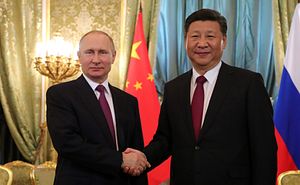Climate change has resulted in the rapid retreat of Arctic sea ice. The Northern Sea Route, one of three Arctic shipping routes that connect East Asia and Europe along the Russian coastline, is now subject to more attention than ever before. The Northern Sea Route Administration notes that in 2016 traffic volume on the Northern Sea Route reached 7,265,700 tonnes – an increase of 35 percent in comparison with 2015.
As the world’s third largest ship-owner, China has a strong interest in Arctic shipping, especially in the Northern Sea Route. That was reflected in China’s decision to include the Arctic in its Belt and Road Initiative. On June 20, 2017, China’s National Development and Reform Commission and State Oceanic Administration published the “Vision for Maritime Cooperation under the Belt and Road Initiative” (the Vision). The Vision officially incorporates the Arctic into China’s Belt and Road Initiative (BRI).
Moreover, before attending the G20 Summit in Hamburg, President Xi Jinping visited Russia and signed the “China-Russia Joint Declaration on Further Strengthening Comprehensive, Strategic and Cooperative Partnership” (Joint Declaration) on July 4, 2017. Described as the Ice Silk Road, the development of the Northern Sea Route is a key area of cooperation between China and Russia.
The Ice Silk Road can be seen as a further step in shaping China’s Arctic policy. The three main pillars of this policy are: respect, cooperation, and sustainability. Moreover, the BRI now officially extends to the Arctic, which could help achieve the objectives of China’s Arctic policy. It is now very clear that China is keen to play a role as a user of the Northern Sea Route. As elaborated in the Vision:
China is willing to work with all parties in conducting scientific surveys of navigational routes, setting up land-based monitoring stations, carrying out research on climatic and environmental changes in the Arctic, as well as providing navigational forecasting services. China supports efforts by countries bordering the Arctic in improving marine transportation conditions, and encourages Chinese enterprises to take part in the commercial use of the Arctic route.
So why is China keen to use the Northern Sea Route? It is commonly known that the Northern Sea Route could shorten the distance of transportation between China and European ports. China also sees the opportunity of resources development in the Russian Arctic, such as through the Yamal LNG project. Perhaps more importantly, China believes that the Northern Sea Route is strategically important for its energy security. China is facing the dilemma that energy from Africa and the Persian Gulf passes through waters dominated by strategic competitors (the United States and India), threatened by piracy, or bottle-necked at the Strait of Malacca. It would therefore be helpful to have an alternative shipping route along a politically stable area.
However, China’s Ice Silk Road may face several challenges. First, Russia sees the Northern Sea Route as its internal waters and consequently completely under Russian jurisdiction. Article 234 on “Ice-Covered Areas” of the United Nations Convention on the Law of the Sea (UNCLOS) is interpreted by Russia as the legal basis for its exclusive jurisdiction of the Northern Sea Route — unlike the United States, which views the Northwest Passage and the Northern Sea Route as a strait used for international navigation. China appears uninterested in challenging Russia’s jurisdiction in the Northern Sea Route.
In 2012, Russia adopted new regulations that abolished the compulsory guidance of foreign vessels through the Northern Sea Route by Russian icebreakers and pilots. This makes it easier for various shipping companies to explore the Northern Sea Route, including Yong Sheng of China Ocean Shipping Company. To date, Yong Sheng has sailed through the Northern Sea Route three times, all with pre-approvals from the Russian administration. Based on Yong Sheng’s experience, the China Ministry of Transport published the Guidebook for Chinese Shipping in the Northern Sea Route in 2014.
Chinese practice with regards to the Northern Sea Route is in line with China’s Arctic policy of mutual respect. That is, China recognizes sovereignty and sovereign rights of Arctic states, while Arctic states in turn respect China’s legitimate rights under international law, such as the freedom of navigation. Nevertheless, UNCLOS does not grant freedom of navigation in internal waters. If Chinese vessels become a frequent user of the Northern Sea Route in the future, they will be completely subject to Russian legislation and authority.
Second, though the use of Northern Sea Route will shave nine to ten days off a journey between China and European markets (as compared to the traditional routes via the Strait of Malacca and Suez Canal) it is not economically viable in the foreseeable future. Shipping in the Arctic, a harsh and remote environment, imposes extra demands on ships, their systems, and operations. So far China lacks expertise on almost all fronts. For example, Chinese ship builders will need to build polar-class ships. This is why China is eager to seek cooperation with Finland and Russia regarding Arctic marine technology. It will also take time to train seafarers. Moreover, given the vulnerability of the Arctic environment, a small ship accident could cause serious environmental damage. The insurance costs will therefore be much higher for vessels sailing in the Arctic than in other warmer parts of the world.
In short, as long as solid Russia-China relations exist, the future of the Ice Silk Road is bright. Russia is keen to embrace China’s BRI for investment and technology. At the same time China is very interested in the Arctic. Nevertheless, apart from elaborating cooperative fields, China should develop a concrete position on the international legal status of the Northern Sea Route while bearing in mind the high costs of using the Route in the foreseeable future.
Nengye Liu is a senior lecturer at Adelaide Law School, University of Adelaide, Australia.

































